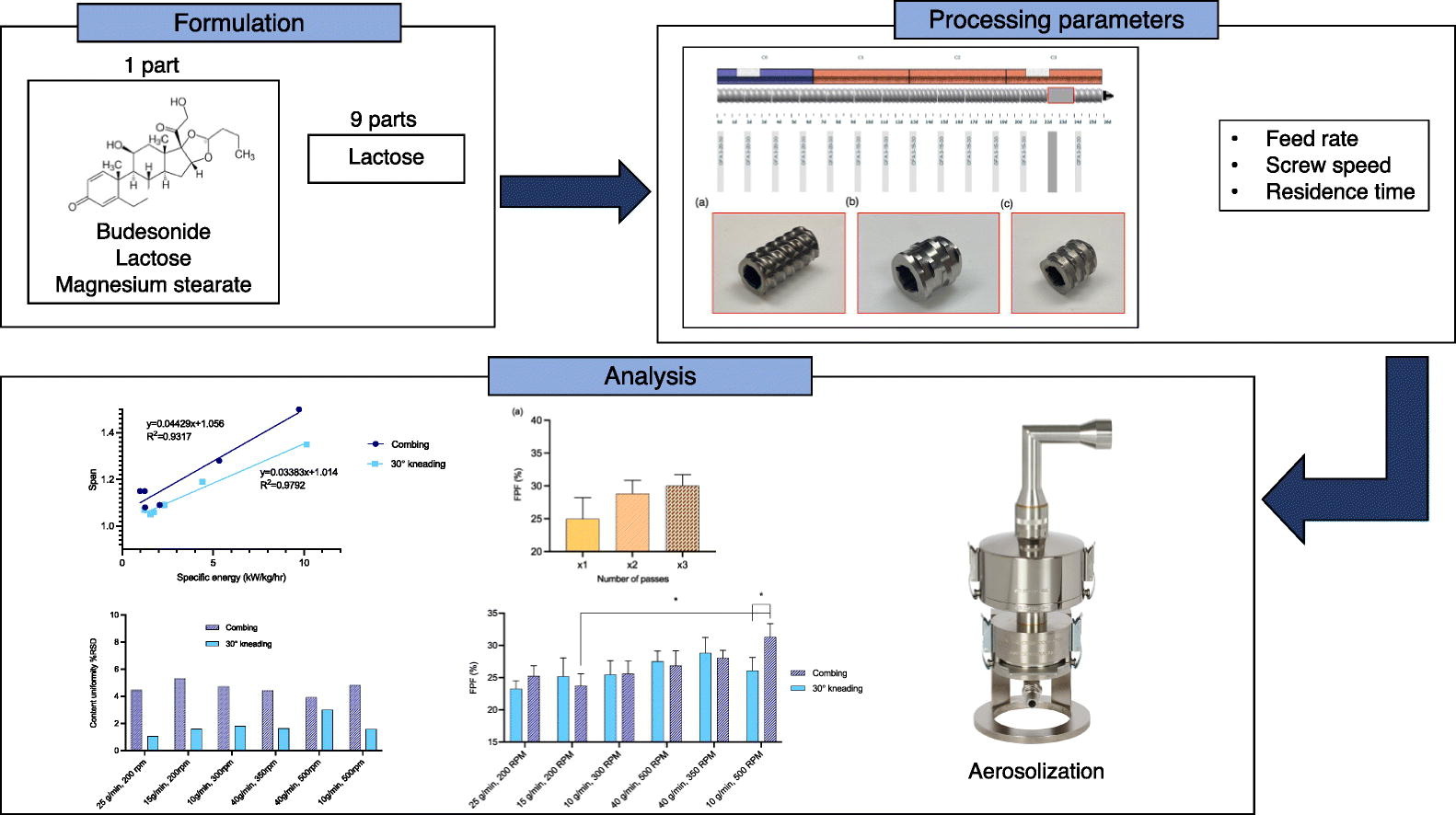Twin-screw continuous mixing: Effect of mixing elements and processing parameters on properties of aerosol powders

Twin-screw continuous mixing was used to prepare aerosol powders containing 1% budesonide, 0.3% magnesium stearate, and 98.7% α–lactose monohydrate. The effect of mixing configuration was studied using three screw profiles containing either a combing element, 30° forward kneading element, or a 60° forward kneading element. The impact of screw speed, feed rate, and multiple passes through the mixer on powder quality was investigated. The impact of specific energy on aerosol performance was dependent on the mixing configuration, and high energy input was detrimental to FPF for the 30° kneading element. Control of content uniformity was demonstrated by varying the mixing element in the screw profile. Passing the material through the mixer multiple times improved the aerosol performance. The robust and tunable nature of twin-screw mixing makes it a process well suited for continuous manufacturing of aerosol powders.
Introduction
Dry powder inhalers (DPIs) are commonly used for pulmonary delivery of drugs [[1], [2], [3]]. DPIs containing various drugs have been developed to treat a number of illnesses, including asthma, cystic fibrosis, and chronic obstructive pulmonary disease (COPD) [4,5]. The micronized active is commonly combined with a larger carrier material such as α-lactose monohydrate to improve flow properties and promote uniform dosing [6,7]. The aerosol powders are typically prepared using batch mixers, such as high shear or tumble mixers [8,9]. They are then packaged in individual doses or stored in a reservoir and dosed during patient use. The active is often micronized to obtain a particle size distribution between 1 and 5 μm, rendering the mixing step critical for obtaining homogeneous powders with accurate drug loading. Batch-to-batch variability is a widely known issue amongst DPI manufacturing [10,11]. Physicochemical differences between batches creates pharmacokinetic variability that can result in bio-inequivalence [12]. Our group recently published two articles of a three-part series of studies that demonstrated a novel continuous manufacturing method to prepare inhaled powders using a twin-screw corotating extruder [13,14]. These studies showed that twin-screw continuous mixing can effectively manufacture uniform powders with desirable aerosol properties and that low-level lubricant is required as a processing agent to facilitate uniform powder flow during mixing. In the second publication, twin-screw mixing produced improved aerosol performance compared to low shear Turbula mixing and similar performance compared to high shear mixing. In this third study, we have expanded on the prior mentioned works by investigating the effect of mixing element, processing conditions, and residence time on content uniformity and aerosolization.
Twin-screw continuous manufacturing has been used for several different pharmaceutical applications, including amorphous solid dispersions, melt and wet granulation [[15], [16], [17]]. The benefit of twin-screw extruders lies in its modularity, which allows for customized configurations by varying the screw profile. Different shear profiles can be generated which will vary the relative dispersive and distributive mixing forces applied to the material [18]. The effect of screw profile on product performance has been evaluated in numerous applications [19,20]. However, this is the first study in which the impact of screw profile is being investigated for aerosol dry powder manufacturing. Mixing energy input is a critical parameter as there must be a balance between sufficient mixing to achieve uniform drug distribution and avoiding press-on forces [21,22]. Studies have shown that extreme high shear mixing environments can adversely affect fine particle fraction (FPF) [8]. Since FPF indicates the efficiency of dispersion and relates to the amount of drug depositing in the lung, evaluation of processing parameters such as screw profile and mixing time on FPF is of critical importance. Furthermore, inhalation formulations may contain drug loadings at or below 1%, so high recovery and content uniformity of drug is required.
The Leistritz 16 mm twin-screw corotating extruder was used in this study, which has a process volume of about 20 mL. The continuous nature of this system means that each portion of material will encounter the same mixing history, resulting in blends with uniform content. The tight clearance between screw flights and the barrel wall completely pushes material out of the barrel to prevent losses inside the extruder. Importantly, the corotating screws form an intermesh region between the two sets of screws, where material is transferred from one screw shaft to the other. This mechanism of material flow is known as “self-wiping” and is a property unique to corotating twin-screw mixers [23]. The self-wiping nature is beneficial for preparing aerosol powders, where drug agglomerates must be reduced to finer particle sizes and uniformly layered on the lactose surface to achieve acceptable aerosolization. In this study we prepared budesonide aerosol powders at different combinations of screw speed and feed rate while varying mixing element. Blends were assessed for budesonide content uniformity and aerosol performance testing was conducted using a fast-screening impactor (FSI) to determine FPF.
Read more on Twin-screw continuous mixing
Materials
Budesonide was obtained from Nexconn Pharmatechs (Shenzhen, China). Magnesium stearate was obtained from Macron Chemicals (Radnor, PA). Lactose monohydrate (InhaLac 230) was purchased from Meggle (Wasserburg, Germany). Size 3 hydroxypropyl methylcellulose capsules were generously gifted by Capsugel (Morristown, NJ). 200 proof ethanol was purchased from Decon Labs (King of Prussia, PA), and analytical grade acetonitrile and methanol from Fisher Chemical (Hampton, NH).
Angela Ren, Jamie E. Spahn, Hugh D.C. Smyth, Feng Zhang, Twin-screw continuous mixing: Effect of mixing elements and processing parameters on properties of aerosol powders, Powder Technology, Volume 424, 2023, 118519, ISSN 0032-5910, https://doi.org/10.1016/j.powtec.2023.118519.
Read more about Magnesium Stearate as a pharmaceutical excipient here


